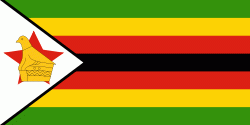Shurugwi
Shurugwi, formerly Selukwe, is a small town and administrative centre in Midlands Province, southern Zimbabwe, located about 350 km (220 miles) south of Harare, with a population of 22,900 according to the 2022 census. The town was established in 1899 on the Selukwe Goldfield, which itself was discovered in the early 1890s not long after the annexation of Rhodesia by the Pioneer Column.
The town lies in well wooded, hilly and picturesque country at an altitude of about 1,440 metres (4700') and is well watered having a typical annual rainfall of 89 cm (3'). On a clear day it is quite possible to see the hills around Masvingo and Great Zimbabwe, the latter being over 145 km (90 miles) away.
Selukwe was established in 1899 by the British South Africa Company and Willoughby's Consolidated Company. Its name was derived from a nearby bare oval granite hill that resembled the shape of a pigpen (selukwe) of the local Karanga people.
The district remains an important centre for gold, chrome and platinum mining, but is perhaps best known as the home district of Ian Douglas Smith, a former Prime Minister of Rhodesia, who owned the 4,000 acre Gwenoro Farm near Gwenoro Dam.
The town lies in well wooded, hilly and picturesque country at an altitude of about 1,440 metres (4700') and is well watered having a typical annual rainfall of 89 cm (3'). On a clear day it is quite possible to see the hills around Masvingo and Great Zimbabwe, the latter being over 145 km (90 miles) away.
Selukwe was established in 1899 by the British South Africa Company and Willoughby's Consolidated Company. Its name was derived from a nearby bare oval granite hill that resembled the shape of a pigpen (selukwe) of the local Karanga people.
The district remains an important centre for gold, chrome and platinum mining, but is perhaps best known as the home district of Ian Douglas Smith, a former Prime Minister of Rhodesia, who owned the 4,000 acre Gwenoro Farm near Gwenoro Dam.
Map - Shurugwi
Map
Country - Zimbabwe
 |
 |
| Flag of Zimbabwe | |
The British South Africa Company of Cecil Rhodes demarcated the Rhodesia region in 1890 when they conquered Mashonaland and later in 1893 Matabeleland after a fierce resistance by Matabele people known as the First Matabele War. Company rule ended in 1923 with the establishment of Southern Rhodesia as a self-governing British colony. In 1965, the white minority government unilaterally declared independence as Rhodesia. The state endured international isolation and a 15-year guerrilla war with black nationalist forces; this culminated in a peace agreement that established universal enfranchisement and de jure sovereignty as Zimbabwe in April 1980. Zimbabwe then joined the Commonwealth of Nations, from which it was suspended in 2002 for breaches of international law by its government under Robert Mugabe and from which it withdrew in December 2003.
Currency / Language
| ISO | Currency | Symbol | Significant figures |
|---|---|---|---|
| ZWL | Zimbabwean dollar | 2 |
| ISO | Language |
|---|---|
| SN | Shona language |















